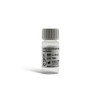Description
IAXO-102 (CD14/TLR4 Antagonist) (synthetic) | IAX-600-002-M001
Methyl 6-Deoxy-6-amino-2,3-di-O-tetradecyl-α-D-glucopyranoside
Small molecule CD14/TLR4 ligand/modulator. Glycolipid. Lipid A analogue. Inhibitor of sterile inflammation.
Persistent inflammation has been implicated in the pathogenesis not only of diverse chronic diseases such as neuropathic pain, atherosclerosis, chronic hepatitis, and abdominal aortic aneurysm, but also acute organ failure, cardiac infarct and stroke.
The Toll-like receptor (TLR) family members are key contributors to these pro- inflammatory conditions. These pattern recognition receptors respond to molecular patterns in components of bacteria and viruses. In addition to their role in detecting pathogen associated molecular patterns (PAMPs), TLRs can also sense endogenous danger (or tissue damage) associated molecular patterns (DAMPs) and have been implicated in perpetuating inflammatory cascades in the absence of invading microbes or other pathogens.
TLR4’s well-known key role in orchestrating innate and adaptive immune response to Gram-negative bacteria now extends into the area of mediating auto-inflammation and tissue repair and re-modelling.
As research tools IAXOs are useful to explore CD14-dependent and TLR4-independent pathways and TLR4 activation by endogenous ligands (e.g. hyaluronic acid oligosaccharides, oxLDL, HMGB1) in sterile inflammation. In pre-clinical models IAXO compounds have been shown to inhibit neuropathic pain [1]; secondary necrosis of acute drug-induced liver failure [3] and vascular inflammation and abdominal aortic aneurysm [6] by blocking non-hematopoietic TLR4 signaling. IAXO compounds hold considerable promise in pharmacological settings, where inhibition of sterile (auto-) inflammation is desired, without compromising TLR4’s key role in the defense of pathogens.
IAXO compounds hold considerable promise in pharmacological settings, where inhibition of sterile (auto-) inflammation is desired, without compromising TLR4’s key role in the defense of pathogens. CD14-dependent and independent TLR4 activation in the central nervous system by endogenous factors has been recently related to a wide array of inflammatory neurological diseases such as amyotrophic lateral sclerosis [7] and Alzheimer’s disease.
Product Specific References
[1] TLR4 receptor as new target to treat neuropathic pain: efficacy of a new receptor antagonist in a model of peripheral nerve injury in mice. Bettoni I, et al. Glia (2008); 56:1312
[2] Exploring the LPS/TLR4 signal pathway with small molecules. Peri F, et al.; Biochem Soc Trans. (2010); 38:1390 REVIEW
[3] Toll like receptor 4 antagonist prevents acetaminophen induced acute liver failure in mice: a novel therapeutic strategy. Shah N, et al.; Gut (2012); 61:A28
[4] Multivalent glycoconjugates as anti-pathogenic agents. Bernardi A, et al.; Chem Soc Rev. (2013); 42:4709 REVIEW
[5] Toll-like receptor 4 (TLR4) modulation by synthetic and natural compounds: an update. Peri F, Calabrese V. Med Chem. (2014); 57:3612 REVIEW
[6] A novel small molecule TLR4 antagonist (IAXO-102) negatively regulates non-hematopoietic toll like receptor 4 signalling and inhibits aortic aneurysms development.. Huggins C, et al. Atherosclerosis. 242:563 (2015). Journal Article
[7] Synthetic and natural small molecule TLR4 antagonists inhibit motoneuron death in cultures from ALS mouse model. De Paola M, et al. Pharmacol Res. 103:180 (2016) Pubmed Abstract
[8] Effects of Toll-Like Receptor 4 Antagonists Against Cerebral Vasospasm After Experimental Subarachnoid Hemorrhage in Mice. Kawakita F., et al. Mol Neurobiol 54:6624-6633 (2017) Pubmed Abstract


-204-p__09187.1660057300.jpg?c=1)
-204-p__24416.1660057300.jpg?c=1)

-204-p__09187.1660057300.jpg?c=1)
-204-p__24416.1660057300.jpg?c=1)






